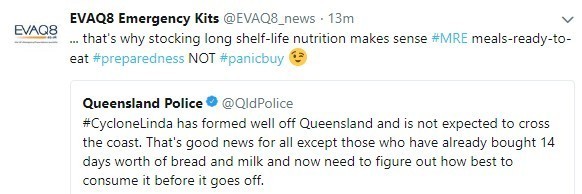
Is personal preparedness (home, work, travel) on your New Year’s resolution list? It should be.
Start now, it’s never too late 🙂
Welcome to 2018 and yet another year of blogs about how to be better prepared and build personal and community preparedness and resilience.
Looking at the named UK storms 2017/8 and story of the first half of January, we may well need it ….
2018 so far …
– record-breaking cold in US/Canada
– record-breaking heat in Oz
– snow in the Sahara
– extreme snowfall in the Alps
– disastrous mudslides in California
– exceptional heat in Argentina
… and it’s only Day 10! pic.twitter.com/tXk33fBLFE— Matt Taylor (@MetMattTaylor) January 10, 2018
Last year this blog opened optimistically with Welcome to 2017 – be prepared, not scared highlighting the launch of the citizenAID app and how personal preparedness is being taken much more seriously at all levels. Looking back now, it seems those were good omens. One thing in particular stands out for me: the 2017 ‘September is Preparedness Month’ campaign was a huge success, a much larger number of organisation and individuals collaborated, reaching audiences right across the United Kingdom (see 30days30waysUK.org.uk and their report ).
September 2017 was special in a another aspect too: that same month, the new UK National Risk Register was released.
The new National Risk Register is out today #NRR It’s very different! Take a look https://t.co/5BpSTvfZgm #prepared #understandRisk pic.twitter.com/MvuJeZBmzl — EVAQ8 Emergency Kits (@EVAQ8_news) September 15, 2017
Even just a cursory glance at the new National Risk Register will quickly reveal that much has changed in the way UK government now communicates about risk, resilience and preparedness. The way I see it, it’s a huge step in the right direction, simplifying and streamlining important messages using language and graphics in really effective ways to alter people’s beliefs about and behaviour towards risks.
Science1 backs this up:
- poor risk communication can lead to confusion, distrust and potentially fatal outcomes
- people’s responses to risk are better when risk is communicated visually, across multiple formats…and when communication is personalized
- people’s perception of risk is shaped by many factors, including the language used to communicate the risk, the type of risk and cultural factors as well as individual attributes such as gender and age
That last aspect, individual attributes, is interesting because research has shown that men have a higher appetite for and tend to underestimate risk as compared to women. However, it’s not that simple and there are mediating factors such as age. To that I would also add ‘previous exposure’ for many who have experienced a major incident, emergency or disaster first hand, tend to re-evaluate their personal preparedness with a much more serious view. But, sadly, not all and there are Resilience and Preparedness Roadblocks which may affect us all.
With regards to risk perception and appetite, this is an interesting chart borrowed from the Chartered Institute of Internal Auditors. When I saw this it made me think that internal audits despite being business oriented are a good ‘bridge’ and methaphor also for personal audits, personal risk understanding and preparedness.

Source: www.iia.org.uk/media/599131/risk-appetite-3.jpg
So, last month’s December weather with extremes in temperatures, precipitation and winds including two named UK storms to boot is luckily behind us but we’re certainly not out of the woods just yet. In addition, there are always aspects of personal security and safety to consider which are very much part and parcel of personal preparedness.
For more preparedness resources check out our hub, browse the blog navigation as well as the top navigation of the website. And remember to follow us on social media where we share tips, updates and prize lotteries to keep you informed and kitted. More links below.
Wishing you belated a very happy and prepared New Year 2018.
Monika
1 2017 “Communicating Risk”, Parliamentary Office of Science and Technology, POST note 564
If you like this post, please share it to help raise awareness for Emergency and Disaster Preparedness.
Tweet thank you for sharing!
For more EVAQ8 blog simply use the right hand navigation. For emergency kits and practical resources use the top navigation. For FREE resources head over to our Preparedness Hub and find out why we use humour. If you like this post, please share it to help raise awareness for Emergency and Disaster Preparedness. Thank you!
Find EVAQ8 on social media, like and follow us!








 As a somewhat removed Swiss observer yet from ‘within so to speak as someone who lives here I am continually amazed at the British: the speed and boundless generosity with which communities have come together, pooling resources and sheer man (and woman and child!) power to help each another as well as to offer help across wider areas. In fact, generosity is and was so overwhelming that this morning the local newspaper
As a somewhat removed Swiss observer yet from ‘within so to speak as someone who lives here I am continually amazed at the British: the speed and boundless generosity with which communities have come together, pooling resources and sheer man (and woman and child!) power to help each another as well as to offer help across wider areas. In fact, generosity is and was so overwhelming that this morning the local newspaper 

